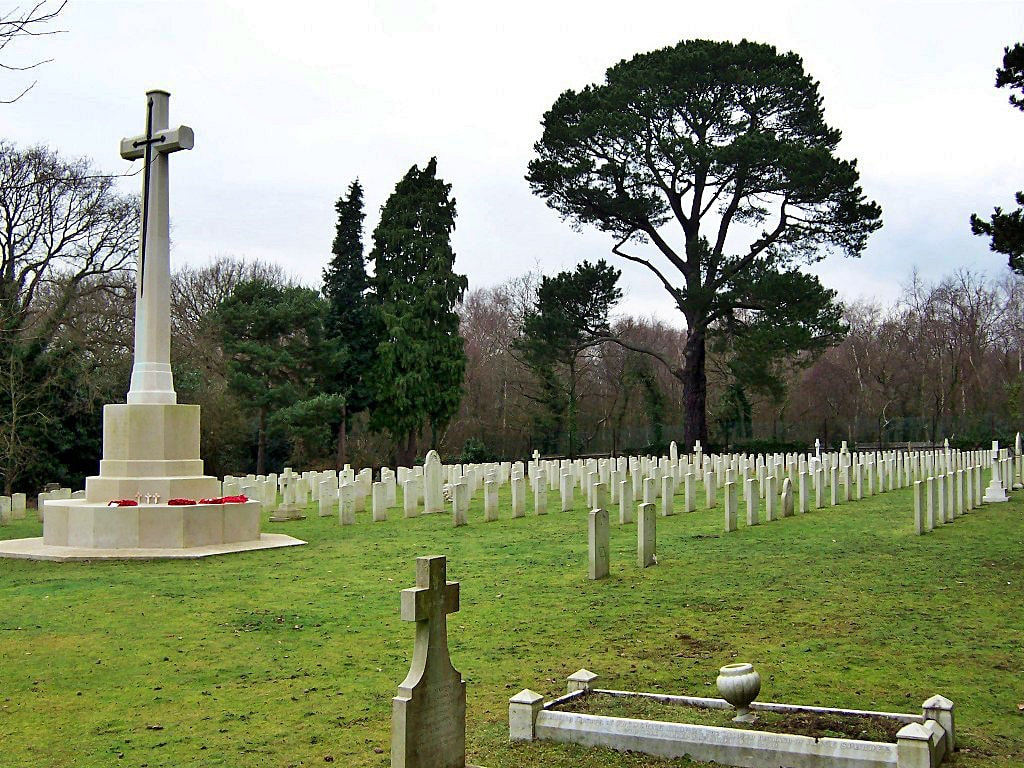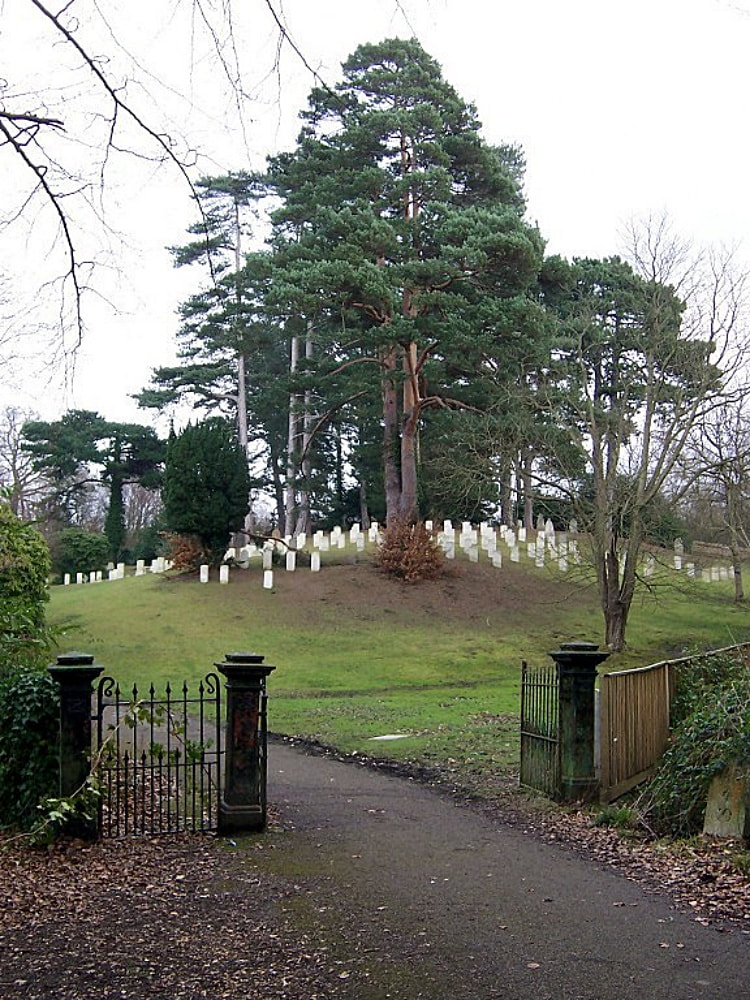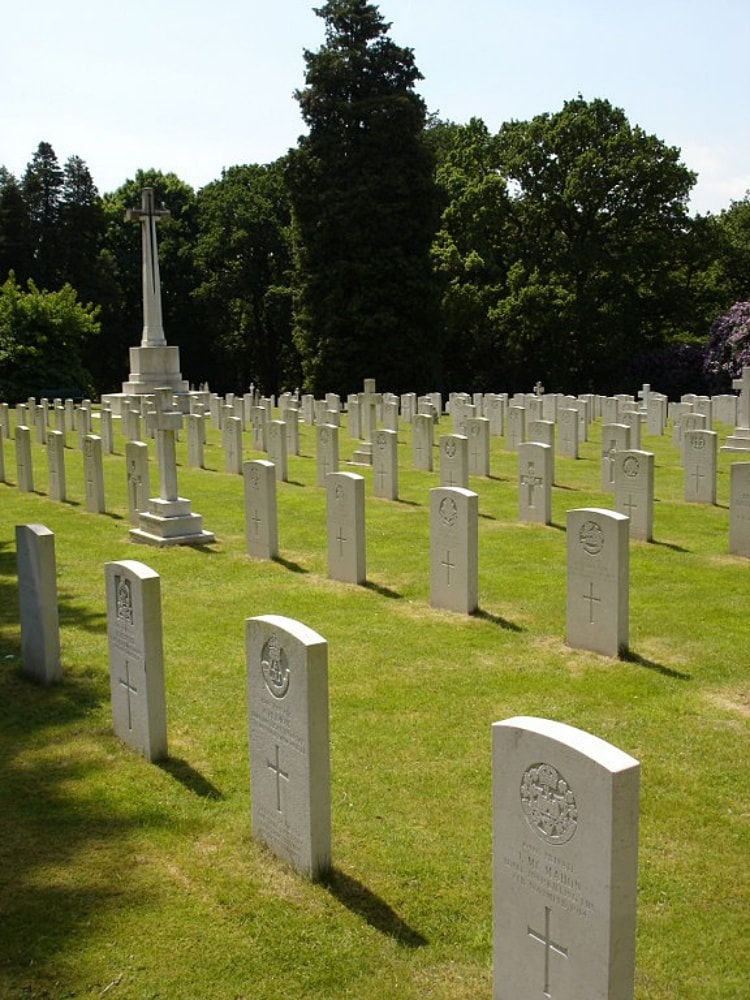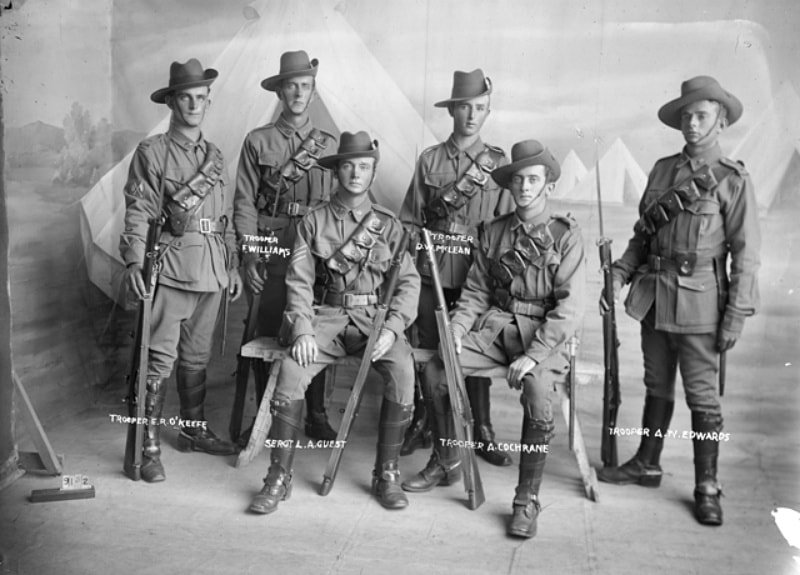NETLEY MILITARY CEMETERY
Hampshire
England
GPS Coordinates: Latitude: 50.86609, Longitude: -1.33232
Location Information
The cemetery lies within a park maintained by Hampshire County Council on the site of the former hospital, and access is by way of a private road with a lockable security barrier.
Visiting Information
A Visitor Information Panel has been installed at Netley Military Cemetery to provide information about the war casualties buried here. This is one of many panels being erected to help raise awareness of First and Second World War graves in the UK.
Visitors to the cemetery by vehicle are advised that the key to unlock the barrier is available from the shop next to the Tea Rooms in the Royal Victoria Country Park.
Historical Information
Netley Military Cemetery is a permanent military cemetery, the property of the Ministry of Defence. The cemetery was at the back of the Royal Victoria Military Hospital and was used during both wars for burials from the hospital.
The cemetery contains 637 First World War burials but only 35 from the Second World War. In addition to the Commonwealth graves, there are a number of war graves of other nationalities including 69 German graves dating from the First World War.
Total Commission Burials: 773.
World War One Casualties: United Kingdom 525, Germany 65, Australia 49, Canada 42, Belgium 12, New Zealand 11, South Africa 6, India 4. Total 714.
World War Two Casualties: United Kingdom 33, India 1, New Zealand 1, Poland 1. Total 36.
The cemetery lies within a park maintained by Hampshire County Council on the site of the former hospital, and access is by way of a private road with a lockable security barrier.
Visiting Information
A Visitor Information Panel has been installed at Netley Military Cemetery to provide information about the war casualties buried here. This is one of many panels being erected to help raise awareness of First and Second World War graves in the UK.
Visitors to the cemetery by vehicle are advised that the key to unlock the barrier is available from the shop next to the Tea Rooms in the Royal Victoria Country Park.
Historical Information
Netley Military Cemetery is a permanent military cemetery, the property of the Ministry of Defence. The cemetery was at the back of the Royal Victoria Military Hospital and was used during both wars for burials from the hospital.
The cemetery contains 637 First World War burials but only 35 from the Second World War. In addition to the Commonwealth graves, there are a number of war graves of other nationalities including 69 German graves dating from the First World War.
Total Commission Burials: 773.
World War One Casualties: United Kingdom 525, Germany 65, Australia 49, Canada 42, Belgium 12, New Zealand 11, South Africa 6, India 4. Total 714.
World War Two Casualties: United Kingdom 33, India 1, New Zealand 1, Poland 1. Total 36.
Images in the gallery below used with the permission of the Commonwealth War Graves Commission

2343 Private
John Hector Croft
3rd Bn. Australian Infantry, A.I.F.
27th July 1916, aged 25.
C. E. 1824.
Son of John and Eliza Croft. Born at Mittagong, New South Wales.
Pre enlistment portrait of 2343 Private (Pte) John Hector Croft, 3rd Battalion, of Mittagong, NSW. A drover prior to enlistment, he embarked with the 2nd Reinforcements on HMAT Seang Bee (A48) on 11 February 1915. Pte Croft died at sea on board the Hospital Ship "St George" after receiving gunshot wounds on 27 July 1916, aged 25
John Hector Croft
3rd Bn. Australian Infantry, A.I.F.
27th July 1916, aged 25.
C. E. 1824.
Son of John and Eliza Croft. Born at Mittagong, New South Wales.
Pre enlistment portrait of 2343 Private (Pte) John Hector Croft, 3rd Battalion, of Mittagong, NSW. A drover prior to enlistment, he embarked with the 2nd Reinforcements on HMAT Seang Bee (A48) on 11 February 1915. Pte Croft died at sea on board the Hospital Ship "St George" after receiving gunshot wounds on 27 July 1916, aged 25
Identified 3rd from the left and buried in this cemetery is 1096 Trooper Lambert Adrian Guest, 7th Australian Light Horse
who died on 17th November 1915 after wounds he received at Gallipoli. Son of Edward and Johanna Guest, of Narrabri, New South Wales. His headstone bears the inscription "The Lord Gave And The Lord Hath Taken Away"
He enlisted on 7 December 1914 and embarked from Sydney aboard HMAT Chilka on 7 June 1915.
who died on 17th November 1915 after wounds he received at Gallipoli. Son of Edward and Johanna Guest, of Narrabri, New South Wales. His headstone bears the inscription "The Lord Gave And The Lord Hath Taken Away"
He enlisted on 7 December 1914 and embarked from Sydney aboard HMAT Chilka on 7 June 1915.
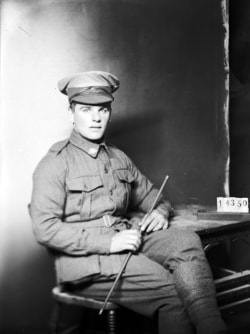
1865A Private
Thomas Arthur Harding
46th Bn. Australian Infantry, A.I.F.
16th September 1916, aged 19.
C. E. 1852.
Son of John Edward and Emily Leah Harding, of Corner of Main and Dawson Sts., Bairnsdale, Victoria. Born at Deptford, Victoria, Australia.
His headstone bears the inscription "Thy Will Be Done O Lord"
Thomas Arthur Harding
46th Bn. Australian Infantry, A.I.F.
16th September 1916, aged 19.
C. E. 1852.
Son of John Edward and Emily Leah Harding, of Corner of Main and Dawson Sts., Bairnsdale, Victoria. Born at Deptford, Victoria, Australia.
His headstone bears the inscription "Thy Will Be Done O Lord"
Five members of the 2nd Field Engineers. The man at the rear is No 98 Sapper George Longworth Jones who enlisted in the A.I.F. on 4 September 1914 and died at Netley Hospital, England, on 27 September 1915, aged 52 of Enteric Fever. Son of George and Selina Jones, of Port Melbourne, Australia; husband of Ida Mary Jones. Born at Coventry, England. His headstone bears the inscription "He Gave His Best His Life, His All For King And Country"
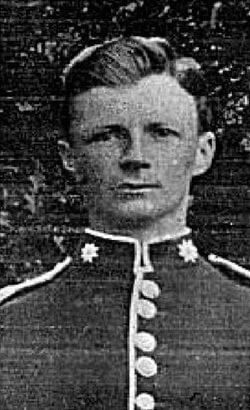
8360 Guardsman
George Henry Peacock
3rd Bn. Coldstream Guards
23rd November 1914, aged 25.
C. E. 1644.
Son of the Rev. F. K. Peacock and Mrs. Peacock, 1, Oak St., Portland Grove, Fallowfield, Manchester. Born at North Leverton, Notts.
His headstone bears the inscription "R. I. P."
The information below supplied by 'The Ellesmerian Club', the alumni organisation for Ellesmere College where George was a pupil.
George Henry Peacock
3rd Bn. Coldstream Guards
23rd November 1914, aged 25.
C. E. 1644.
Son of the Rev. F. K. Peacock and Mrs. Peacock, 1, Oak St., Portland Grove, Fallowfield, Manchester. Born at North Leverton, Notts.
His headstone bears the inscription "R. I. P."
The information below supplied by 'The Ellesmerian Club', the alumni organisation for Ellesmere College where George was a pupil.
George Henry (Harry) Peacock boarded for seven terms at Ellesmere College, from September 1902 to December 1904. Previously he had attended the King Edward VI Grammar School in Retford where he was known as a “very daring, mischevious but loveable boy”. His father, the Reverend Frederick Kitchen Peacock, was Vicar of nearby North Leverton, Lincolnshire.
The family moved around the north of England during George’s early life for he was born at Salford on 30thJanuary 1889. By 1891, they lived at Broughton, and by 1901 they moved again to Lincolnshire where they settled. His mother, Mary Isabella, née Flynnee, came from Leitrim, Ireland, some eighteen years her husband’s junior and his second wife.
During his time at Ellesmere, George represented the ‘Conqueror’ dormitory in the cricket and rugby competitions but would not seem to have been involved in the other activities that a boarding school of the 1900s had to offer.
After leaving Ellesmere, George joined the army for the 1911 Census returns show him to be Private Peacock, Service No. 8360 stationed at Ramillies Barracks, Aldershot in the 2nd Battalion, the Coldstream Guards. This battalion was stationed at Windsor at the outbreak of war on 4th August 1914 and it embarked for France on 12th August. As regular soldiers fully equipped and trained, they were amongst the very first of the British Expeditionary Force to see action on the Western Front.
After their arrival in Europe, the Guards moved into Belgium on 23rd August, but on the same day they were forced to withdraw from Mons as the French withdrew leaving their flank exposed. The retreat concluded on 5th September when having marched one hundred and seventy miles in thirteen days they reached the area south of the Marne.
George also took part in the First Battle of Ypres where he was shot in the left foot on 9th November. He was transferred back to England and taken to the Royal Victoria Military Hospital, Hampshire. Tetanus, however, had set in and George died on 23rd. He was the second Ellesmerian to die in the conflict, the first as a result of active service in Europe. He was buried in the Netley Military Cemetery which lay adjacent to the Military Hospital.
The Retfordian magazine recorded: “George Henry Peacock was wounded on November 7th 1914 somewhere near Ypres. He was brought home and died of tetanus at Netley Hospital on 23rd. Being amongst the very first to go out in August, 1914, he was at Mons and in the drive for the Marne. He was in the 3rd Batt. Coldstream Guards and his photograph shows him in the old uniform of that famous regiment. We remember him as a very daring, mischievous, but loveable boy”.
Being one of the first British soldiers into France, George was awarded the 1914 Star (the Mons Star) and the British War and Victory Medals. His life is commemorated on Memorials at St. Martin’s Church, North Leverton, Habblesthorpe, King Edward VI Grammar School and Ellesmere College.
The family moved around the north of England during George’s early life for he was born at Salford on 30thJanuary 1889. By 1891, they lived at Broughton, and by 1901 they moved again to Lincolnshire where they settled. His mother, Mary Isabella, née Flynnee, came from Leitrim, Ireland, some eighteen years her husband’s junior and his second wife.
During his time at Ellesmere, George represented the ‘Conqueror’ dormitory in the cricket and rugby competitions but would not seem to have been involved in the other activities that a boarding school of the 1900s had to offer.
After leaving Ellesmere, George joined the army for the 1911 Census returns show him to be Private Peacock, Service No. 8360 stationed at Ramillies Barracks, Aldershot in the 2nd Battalion, the Coldstream Guards. This battalion was stationed at Windsor at the outbreak of war on 4th August 1914 and it embarked for France on 12th August. As regular soldiers fully equipped and trained, they were amongst the very first of the British Expeditionary Force to see action on the Western Front.
After their arrival in Europe, the Guards moved into Belgium on 23rd August, but on the same day they were forced to withdraw from Mons as the French withdrew leaving their flank exposed. The retreat concluded on 5th September when having marched one hundred and seventy miles in thirteen days they reached the area south of the Marne.
George also took part in the First Battle of Ypres where he was shot in the left foot on 9th November. He was transferred back to England and taken to the Royal Victoria Military Hospital, Hampshire. Tetanus, however, had set in and George died on 23rd. He was the second Ellesmerian to die in the conflict, the first as a result of active service in Europe. He was buried in the Netley Military Cemetery which lay adjacent to the Military Hospital.
The Retfordian magazine recorded: “George Henry Peacock was wounded on November 7th 1914 somewhere near Ypres. He was brought home and died of tetanus at Netley Hospital on 23rd. Being amongst the very first to go out in August, 1914, he was at Mons and in the drive for the Marne. He was in the 3rd Batt. Coldstream Guards and his photograph shows him in the old uniform of that famous regiment. We remember him as a very daring, mischievous, but loveable boy”.
Being one of the first British soldiers into France, George was awarded the 1914 Star (the Mons Star) and the British War and Victory Medals. His life is commemorated on Memorials at St. Martin’s Church, North Leverton, Habblesthorpe, King Edward VI Grammar School and Ellesmere College.

